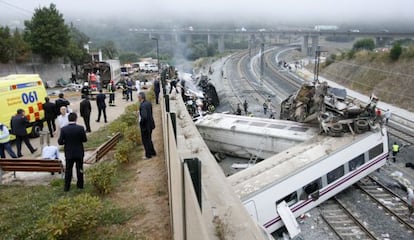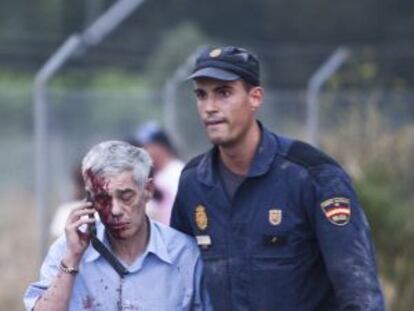Alvia train fail-safe brake was activated twice in 25 minutes before fatal Santiago rail crash
So-called dead man's switch triggers to halt the train if 30 seconds pass without the driver activating it

The Alvia train that crashed due to excessive speed as it headed into Santiago at 8.41pm on July 24, killing 79 people, was already being driven abnormally as it exited Ourense station 40 minutes earlier.
A Renfe report handed to the judge investigating the crash, Luis Aláez, on August 8 states that, according to the black box recorder, the safety brake was activated twice in the 25 minutes preceding the accident. The so-called dead man's switch triggers to halt the train if 30 seconds pass without the driver activating it.
According to the Renfe transcript, which is signed by accident technical investigation chief Manuel Conde García, the train left Ourense station at 8.05pm. Ten minutes later, the black box recorder shows a number of pieces of data that various experts consulted agreed are "strange." At 8.15.19pm, the alert telling driver Francisco José Garzón to press the dead man's switch sounded, then at 8.15.21pm, the train braked automatically, reducing its speed from 110km/h to 48km/h. A minute-and-a-half later, the same thing happened, with the speed decreasing from 109km/h to 86km/h.
The experts consulted all agree that it is an exceptional event for the dead man's switch to be activated, and much more for it to happen twice in a minute. They also agreed it was odd that not one of the passengers had been recorded as noticing at least the first braking maneuver.
During his second session of testimony before Judge Aláez, Garzón, who was appearing at his own request, changed the details of his earlier declaration. The Alvia driver told the court that he had been having a telephone conversation with the conductor on the train just before it derailed on a sharp curve on the way into Santiago.
The conductor says he cannot remember the time he made his phone call to the driver
The driver changed his statement after analysis of the train's electronic devices revealed he had spoken on his company cellphone, but he said he only picked it up because he saw it was the conductor and thought there might have been an emergency.
Garzón told the court that Antonio Martín Marugán and he had spoken about the possibility of entering Pontedeume by the track nearest the station to facilitate the alighting of passengers. The driver denied he had been consulting paperwork at the same time, which investigators suspected after studying the sound on the train's black box recorder. Garzón was asked several times about the phone conversation, which the judge and prosecutors believe was the primary cause of the disaster. The conversation between the driver and conductor lasted about two minutes while the train was traveling at 190km/h. Garzón testified that as soon as he hung up he saw he was approaching the fateful curve at Angrois, where the designated speed limit is 80km/h.
"When I realized I took both the brakes in my hands. I used the electric one, for the motors, and the pneumatic one, for the brake shoes. Normally, to brake more smoothly, you use the electric one and if needs be, a little of the pneumatic; when you need to brake quickly, you use both at full tilt." Asked by the prosecutor where his concentration was during the conversation, Garzón admitted he had lost track of his location. "At that moment I didn't see the danger or the reference point, because if I had, obviously I would have attended to that first and left the phone."
Marugán said in his initial testimony that he only called Garzón once, when the train was stationary in Ourense. However, when presented with the evidence of the second call he admitted the conversation about Pontedeume, but was adamant he could not remember the time of it. Investigators are convinced the call ended exactly 11 seconds before the train slammed into the bend.
Tu suscripción se está usando en otro dispositivo
¿Quieres añadir otro usuario a tu suscripción?
Si continúas leyendo en este dispositivo, no se podrá leer en el otro.
FlechaTu suscripción se está usando en otro dispositivo y solo puedes acceder a EL PAÍS desde un dispositivo a la vez.
Si quieres compartir tu cuenta, cambia tu suscripción a la modalidad Premium, así podrás añadir otro usuario. Cada uno accederá con su propia cuenta de email, lo que os permitirá personalizar vuestra experiencia en EL PAÍS.
¿Tienes una suscripción de empresa? Accede aquí para contratar más cuentas.
En el caso de no saber quién está usando tu cuenta, te recomendamos cambiar tu contraseña aquí.
Si decides continuar compartiendo tu cuenta, este mensaje se mostrará en tu dispositivo y en el de la otra persona que está usando tu cuenta de forma indefinida, afectando a tu experiencia de lectura. Puedes consultar aquí los términos y condiciones de la suscripción digital.









































